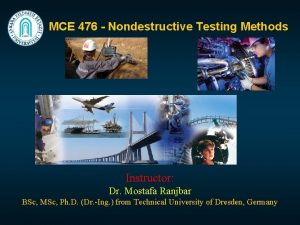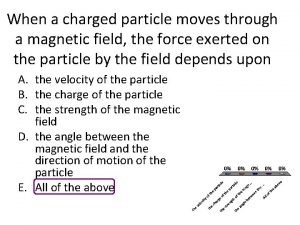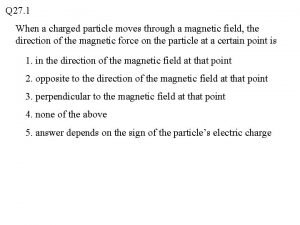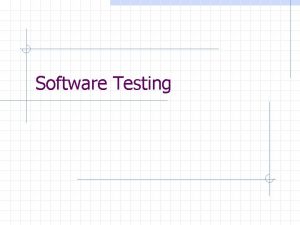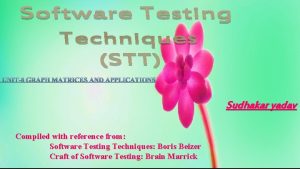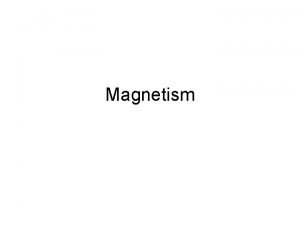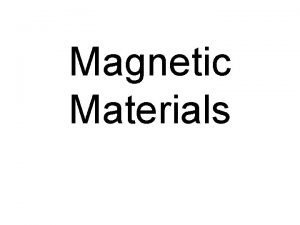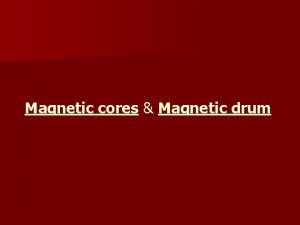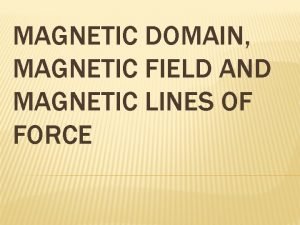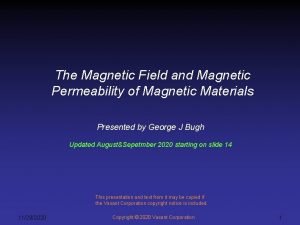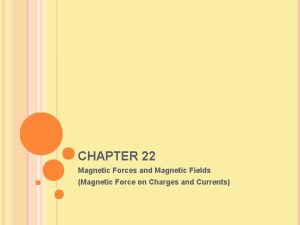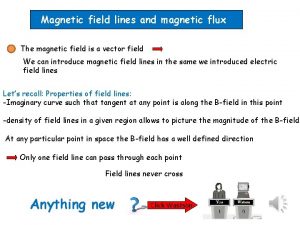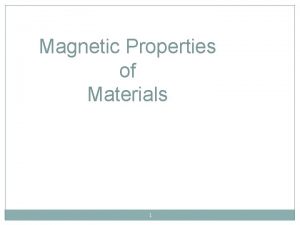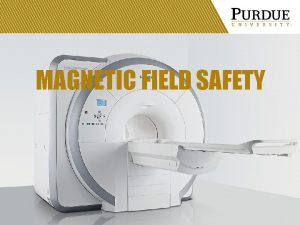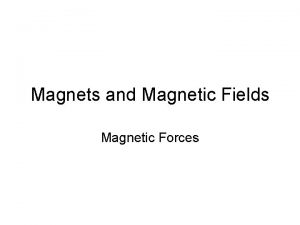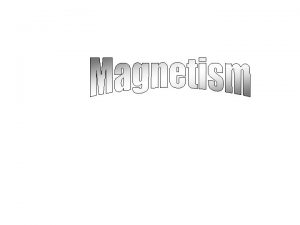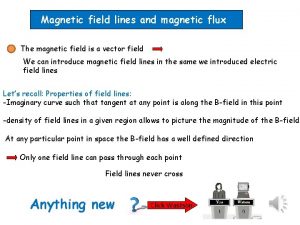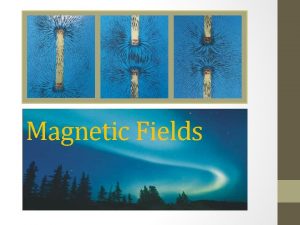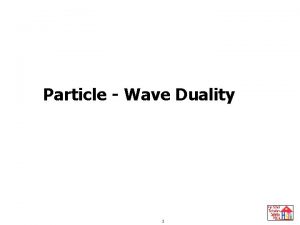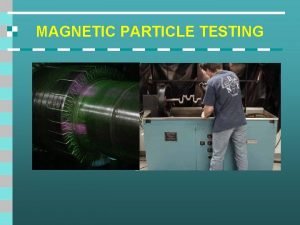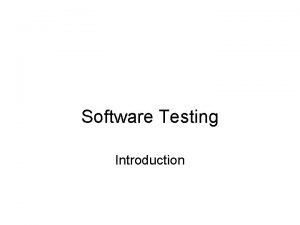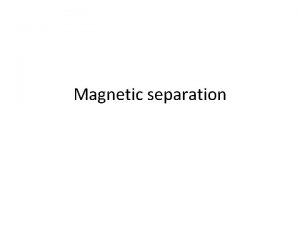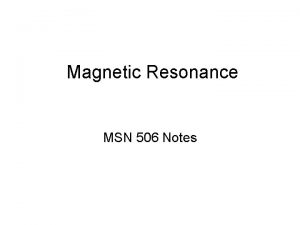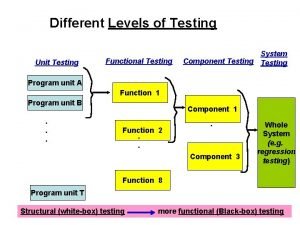Magnetic Particle Testing Magnetic Particle Testing Overview of

























- Slides: 25

Magnetic Particle Testing

Magnetic Particle Testing Overview of Magnetic Particle Testing (MT)/Inspection: § What is MT? § Theory of Magnetism § MT Materials/Equipment § Certification Requirements

Magnetic Particle Testing Definition: An NDT method for location of discontinuities in ferromagnetic materials through utilization of flux leakage that forms magnetic poles to attract finely divided magnetic particles. • One of the oldest and most widely used NDT methods • Its use is limited to ferromagnetic materials – Ferromagnetic materials are materials that can be magnetized to a level that will allow the inspection to be effective – Ex. Iron, nickel, cobalt, and their alloys – “Ferro” is Latin for iron

Magnetic Particle Testing Uses in Industry • Used for inspection of castings, forgings, and weldments on bridges, storage tanks, etc. • Used by the structural steel, automotive, petrochemical, power generation, and aerospace industries • Even used for underwater inspections

Magnetic Particle Testing Basic Steps in an MT Inspection 1) Magnetization of the article 2) Application of the particles (iron filings) 3) Interpretation of the patterns formed by the particles as they are attracted by magnetic leakage fields 4) Demagnetization of the article if required

Magnetic Particle Testing What is a Magnet? • A magnet is a material that has its north and south poles aligned and will attract iron • Magnetism may be naturally present in a material or the material may be artificially magnetized by various methods • Magnets may be permanent or temporary

Magnetic Particle Testing Magnetic Poles • A magnetic pole is any place where magnetic lines of force enter or exit a magnet • A magnet has two opposite poles that are attracted by the Earth’s magnetic poles • If a magnet has poles it exhibits polarity • Lines of force – Called magnetic flux – Exit the magnet at the north pole – Enter the magnet at the south pole – Never cross – Seek the path of least magnetic resistance

Magnetic Particle Testing More About Magnetic Poles • Like poles repel (N and N, S and S) • Opposite poles attract (N and S) • Longitudinal magnetization occurs in bar magnets which have two poles • No external poles exist in a circular magnetic field

Magnetic Particle Testing Magnetic Fields • A magnetic field is the space within and surrounding a magnetized article, or a conductor carrying a current, in which a magnetic force is present • A magnetic field surrounding a bar magnet is shown below

Magnetic Particle Testing Flux Leakage • If a bar magnet is broken in two, two complete bar magnets with magnetic poles on the ends of each piece will result • However, if a magnet is just cracked but not broken completely in two, a north and south pole will form at each edge of the crack

Magnetic Particle Testing Flux Leakage (Continued) • A magnetic field exists at the crack – it exits at the north pole, re-enters at the south pole • It spreads out when it encounters the small air gap created by the crack because the air cannot support as much magnetic field per unit volume as the magnet can • When the field spreads out, it appears to leak out of the material and, thus is called a flux leakage field.

Magnetic Particle Testing Flux Leakage (Continued) • Magnetic particle testing uses the presence of leakage fields to detect the presence of discontinuities • Iron filings are drawn to the leakage fields

Magnetic Particle Testing Brief History of MT • 1868 – earliest known use of magnetism to inspect an object – Use of compasses to check for defects along a cannon barrel that had been magnetized • 1920 s – William Hoke noticed that metallic grindings from hard steel parts (held by a magnetic chuck while being ground) formed patterns on the face of the parts which corresponded to the cracks in the surface • 1930 s – MT replaced the “oil-and-whiting” method in the railroad industry

Magnetic Particle Testing Material Definitions Diamagnetic materials (have paired electrons) • Cannot be magnetized and are repelled by magnetism • Include most elements (copper, gold, and silver) Paramagnetic materials • Have a weak magnetic field and do not retain magnetic properties once external field removed • Ex. Magnesium, molybdenum, lithium, and tantalum Ferromagnetic materials • Can be strongly magnetized and retain magnetic properties once external field removed • Can be tested by MT

Magnetic Particle Testing Electromagnetic Fields When an electric current is passed through a conductor a magnetic field is formed • Field is strongest at surface of the conductor • Field strength decreases with distance from conductor Direction of magnetic field (lines of force) perpendicular to current • If current travels in a straight line, the lines of force will be circular • If current travels in a loop (a coil), the lines of force will be in a straight line – Field strength proportional to number of coil loops and amount of current

Magnetic Particle Testing Example of the Right-Hand Rule

Magnetic Particle Testing Units • Magnetizing force - the total electrical force required to set up a flux in a magnetic circuit – H (ampere/meter) • Magnetic flux - the total number of lines of magnetic force in a material – Ф (weber = tesla/square meter in SI; maxwell in CGS) • Flux density – flux per unit area through an element – B (tesla in SI units; gauss in CGS)

Magnetic Particle Testing Other Definitions • Permeability – the ease with which a material can be magnetized – Can be calculated by B/H (ratio of flux density to magnetizing force) • Reluctance - the opposition of a magnetic material to the establishment of a magnetic field – High permeability means low reluctance (and vice versa) – Analogous to resistance in an electrical circuit

Magnetic Particle Testing Other Definitions Continued • Residual magnetism – the amount of magnetism that remains in a material after removal of the magnetizing force (also called its retentivity) – High residual magnetism calls for demagnetization • Coercive force – the reverse magnetizing force necessary to remove the residual magnetism so as to demagnetize an article

Magnetic Particle Testing Hysteresis Loop A great deal of information can be learned about the magnetic properties of a material by studying its hysteresis loop. A hysteresis loop shows the relationship between the induced magnetic flux density (b) and the magnetizing force (h). It is often referred to as the b-h loop. An example hysteresis loop is shown below and on the next slide.

Magnetic Particle Testing

Magnetic Particle Testing Hysteresis Loop • Wide hysteresis loop – Low permeability therefore high reluctance (difficult to magnetize) – High retentivity and residual magnetism – once the part is magnetized it keeps its magnetism – Will make a good permanent magnet • Slender hysteresis loop – High permeability therefore low reluctance (easy to magnetize) – Low reluctance and residual magnetism

Magnetic Particle Testing Direct Vs. Indirect Magnetization There are two methods for inducing a magnetic field into a part: • Direct Magnetization – Electric current is passed directly through the part • “head shot” • prods • Indirect Magnetization – Electric current does not pass through the part • coil • central conductor • yoke

Magnetic Particle Testing Circular vs. Longitudinal Magnetization • Recall that MT detects discontinuities perpendicular to the magnetic lines of force • Typically apply magnetic fields in two directions to improve opportunity for detecting all discontinuities • Circular Magnetic Field – head shot – Central conductor – prods • Induction of a longitudinal magnetic field – coil – yoke

Magnetic Particle Testing Certification Requirements • Per ASNT Recommended Practice No. SNT-TC-1 A, 2011 edition: Certification Level High School Graduate or Equivalent (hrs) Two Years of Engineering or Technical School (hrs) OJT (hours) I 12 8 70 II 8 4 210 Totals: 20 12 280
 Basic principle of magnetic particle testing
Basic principle of magnetic particle testing A charged particle moves through a magnetic field
A charged particle moves through a magnetic field Force on charged particle
Force on charged particle When a charged particle moves in a region of magnetic field
When a charged particle moves in a region of magnetic field Motivational overview in software testing
Motivational overview in software testing Software testing overview
Software testing overview Algori
Algori Hysteresis loop magnetism
Hysteresis loop magnetism Flux in weber
Flux in weber Magnetic moment and magnetic field relation
Magnetic moment and magnetic field relation Domain testing in software testing
Domain testing in software testing Decision table based testing
Decision table based testing Neighborhood integration testing
Neighborhood integration testing Globalization testing example
Globalization testing example Domain example
Domain example Decision table for triangle problem
Decision table for triangle problem Du path testing
Du path testing Rigorous testing in software testing
Rigorous testing in software testing Cause effect graph for triangle problem
Cause effect graph for triangle problem Materi black box testing
Materi black box testing Positive vs negative testing
Positive vs negative testing Testing blindness in software testing
Testing blindness in software testing Control structure testing in software testing
Control structure testing in software testing Behavior testing adalah
Behavior testing adalah Cs3250
Cs3250 Component testing is a black box testing
Component testing is a black box testing
